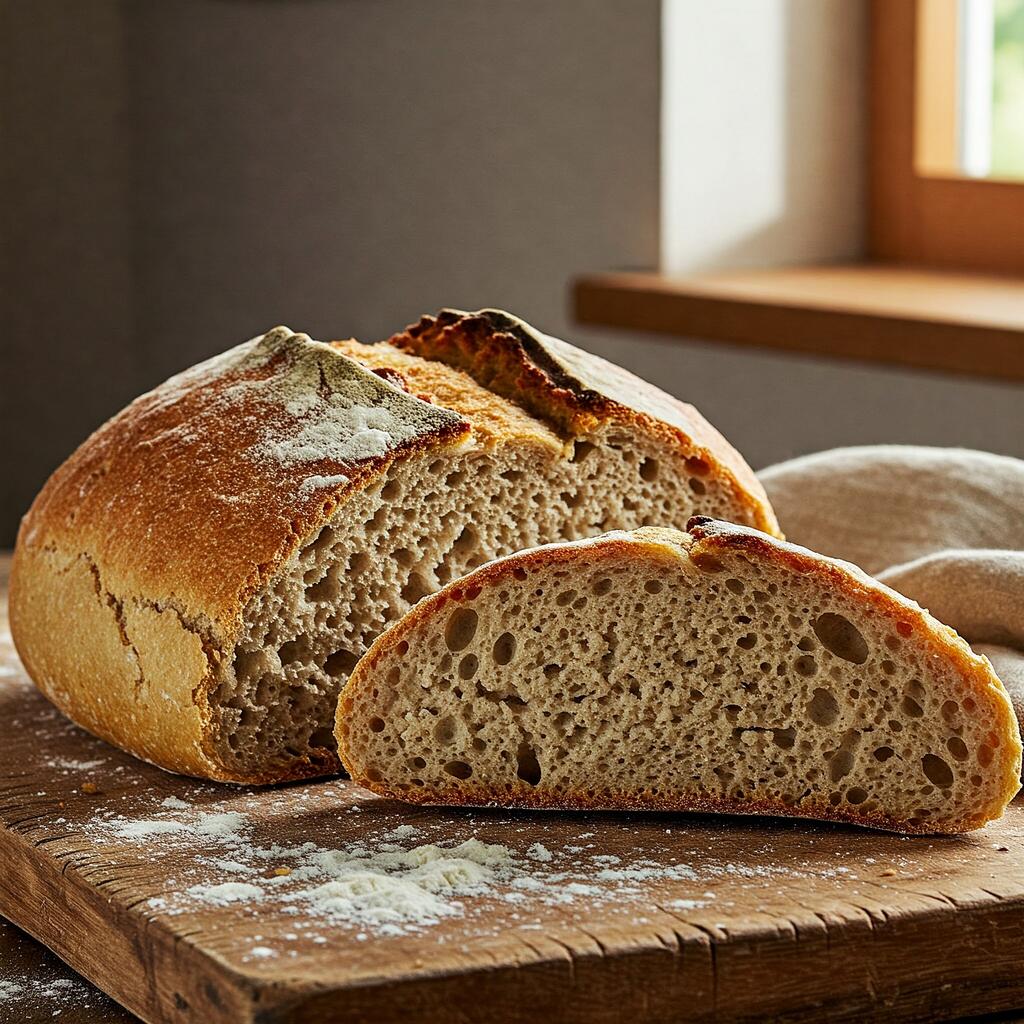
Easy Homemade Tuscan Bread Recipe: Bake It Today!
Today I want to teach you how I make bread. To do things perfectly you would need a wood-fired oven, but instead I have an ordinary electric kitchen oven, as do most people, but I guarantee it comes out good just the same.
Recipe
To make a small loaf of bread that will last 2/3 people a day, you need the following ingredients
- grams 375 of type 0 flour;
- grams. 250 tepid water;
- 12.5 grams of fresh yeast (easily found in any supermarket in a 25-gram packet);
- half a teaspoon of salt;
- half a teaspoon of sugar.
Mix the flour with the water in which you have dissolved the yeast, add the salt and sugar and knead the dough until it is firm. Now place the dough in a tall bowl and cover with cling film and a kitchen towel on top so that the dough remains in the dark.
Leave to rise for about an hour until the dough has doubled in size. At this point, knead the dough with your hands again, adding a little flour if necessary, until you obtain a fairly firm ball. Now we give it the shape we like best, (generally round) and on top of a sheet of baking paper we place it in the container that we will then put in the oven, making a couple of incisions on top of the loaf with a knife.
We cover everything with a kitchen towel and leave the loaf to rise again for another 30 minutes or so.
In the meantime, we raise the oven temperature to 200 degrees, and after the loaf has risen again, we bake it in a hot static oven for about 25 to 30 minutes, depending on the degree of baking you want to achieve. It is best after about 20 minutes to feel that the loaf has already formed a rather hard crust. If so, leave it for another 5 minutes and then remove the loaf from the oven.
I recommend baking it just before dinner or lunch, eaten hot just out of the oven it is a real treat.
To complete
At this point, increasing a little the doses I gave you before, or rather doubling them, you can think about making the Tuscan schiacciata as well.
The dough is the usual and the rising process the same, only at the end, half the dough you have to roll it out with a rolling pin until it forms a sheet of dough about one centimetre high. Place it in a shallow bowl 28/30 cm wide and roll it out with your hands until you reach the edges. With the fingertips of your fingers make many small imprints all over the surface. Add olive oil, possibly spreading it with a small brush or even with your hands until the entire surface is greasy, after which a light dusting of coarse salt. At this point, bake in the oven for about 15 minutes at 200 degrees. Here too, we have to check the cooking time so that our schiacciata is not overcooked.
This, like bread, is delicious in our kitchen oven and can be eaten with cold meats and cheeses, but also on its own.
With the same leavened dough, you can also make fried dough.
We roll out the dough with a rolling pin until we have a sheet about half a centimetre high. Divide it into 6 to 7 cm squares and cook them in hot oil until golden brown. This pastry once cooled a little is excellent to stuff with cheese and cold cuts.
A word of advice
If you are satisfied with your bread or schiacciata and plan to make them often, I recommend a very useful and time-saving purchase. A small planetary mixer. There are different prices, but they are not very expensive, especially as you don't need very big ones, and they have many other uses in the kitchen. For example, in addition to bread and schiacciata, I also make bases for cakes and dumplings with it and it speeds up our recipes a lot and makes the kitchen a lot less dirty.
Although excellent fresh from the oven, this bread keeps well for a couple of days and even if it is no longer crunchy, it remains soft. I recommend wrapping it in aluminium foil or cling film.
A bit of legend, a bit of history
We are in Tuscany, which together with Umbria is the home of silly bread, i.e. without salt, although some towns in Tuscany also make it lightly salted. But the classic Tuscan bread is without salt. It has a crunchy crust while the crumb is firm and soft.
But where does this custom of making bread without salt come from? There are several theories on the subject and one that is definitely right there is not and I believe there never will be, because there are many interpretations and answers to this question.
Some trace the fact of not putting salt in to compensate for the strong flavours of Tuscan main dishes. Just think of ribollita, trippa alla fiorentina, the various soups, pappa col pomodoro, panzanella and especially salumi. Very popular at the time, and even now, was the classic salted ham. However, this theory is refuted by the fact that other regions, especially those in the south, also have a tradition of strong flavours and yet their bread is salty.
Then there is the theory of the war between Pisa and Florence. The most supported theory has it that people started making bread without salt around the 12th century, when Pisa, which was a powerful maritime republic and in whose port salt shipments arrived, in order to create economic damage to Florence with whom it was at war, blocked salt shipments destined for the city. So this is the fact that Florence and Tuscany in general had no salt deposits of its own, and was therefore forced to import salt in other ways, thus raising its price, which was already very high at the time, considerably.
Another theory is based on the fact that, according to some, the custom of making bread without salt derives from the fact that the city of Florence imposed duties and gabelle, i.e., indirect taxes that were paid for certain activities carried out and especially for the revenue gabelle (I think everyone remembers the film with Benigni and Troisi, non ci resta che piangere in which a florin was paid for every passage back and forth).
But above all, Florence financed itself with the tax on salt and hence making a virtue of necessity and removing salt from everything that could be removed, bread included.
However, there are many types of bread in Tuscany. Suffice it to say that not all Tuscan provinces eat bread without salt. Pisa, Lucca and Massa, which were cities that were not part of the Grand Duchy of Tuscany, eat strictly salted bread. One of the best Tuscan sandwiches is produced in the town of Altopascio, which is located in the plain of Lucca. It is a special bread that is made without yeast and without salt. Although close to Lucca, Altopascio was part of the Grand Duchy of Tuscany and therefore its inhabitants were also subject to the salt tax.
Then there is the bozza pratese, which is produced in Prato in the Bisenzio valley and was already known in the 16th century. It is very popular with the inhabitants of Prato and has an elongated shape and a sour taste.
In the Tuscan countryside, wheat was not always sufficient for year-round bread, so the peasants ingeniously used other components, such as maize flour, chestnut flour and even potatoes.
And so different breads were born with the Marocco bread from Montignoso. It was called Marocco because it was dark like a Moroccan inhabitant. It is a speciality that is as old as it is tasty. Maize flour was used, which was much cheaper and more widespread. Wheat flour was very rare and precious at that time and therefore bread made from wheat flour was only used on holidays. Together with the maize flour, black olives, chilli peppers, sage, garlic and rosemary were also mixed in.
Unfortunately, this delicious bread can only be found in the area where it was created, in the province of Massa and Carrara up to Garfagnana. It used to be made only in winter, when olives were available, but now, with olives in brine, it is made all year round. It can also be prepared at home, but it loses much of its original fragrance and texture that it takes on in a wood-fired oven.
The Garfagnana is home to some very special and extraordinary breads, the ‘Neccio’ bread, made of chestnuts, the potato bread, the spelt bread.
The chestnut flour bread
The chestnut is used to produce a flour obtained by drying chestnuts in special casotti (chestnut houses) under fire. Once dried, they were then ground in water mills. Bread was then prepared using chestnut flour together with wheat flour, or in the absence of the latter, boiled potatoes. Among the most famous breads in Tuscan cuisine are the Marocca di Casola and the Necci di Garfagnana.
The Marocca di Casola is a loaf about twenty centimetres in diameter, which was kneaded with chestnut flour, a little Turkish wheat flour, boiled mashed potatoes, mother dough and a little olive oil. Unfortunately, only one bakery is known to produce this bread in Casola, a village in Lunigiana in the province of Massa Carrara.
San Martino bread was traditionally baked in the summer of San Martino (hence the name) on the eleventh of November. It is made with chestnut and wheat flour, brewer's yeast, warm water and chopped walnuts. This type of bread is not only Tuscan however, it is also prepared in many other mountainous areas of Italy.
The necci of Garfagnana, are thin, unleavened flatbreads made only of chestnut flour and water and a pinch of salt. They are cooked on testi, which are stone or cast-iron plates red-hot over the flame of a fireplace or wood stove. They are excellent when accompanied by ricotta cheese, which is traditionally its use, but can also be filled with jam or melted chocolate.
Testarolo and other Tuscan sandwiches
Testarolo is produced in the Pontremoli area and slightly differently in the Lunigiana area. The Pontremoli one is an unleavened bread, i.e. it has no yeast, baked in the traditional ‘testi’ and consists only of flour, water and a pinch of salt. The ciaccino, is a dark brown focaccia that has a curious history.
It is said that this kind of focaccia was used by bakers to test the oven temperature. So this flatbread was put in the oven and if it rose properly, the oven was ready for the second baking, that of the bread. And since in those days nothing was thrown away, this focaccia was used by the bakers as a snack with cold meats and cheeses.
The focaccette of Aulla. There are different variants with white or yellow maize flour dough. They are baked in terracotta texts and are delicious with local cheeses and cold cuts. However, they can only be found at summer festivals in the Aulla area.
Pan di ramerino, is a typical Florentine sweet bread that in ancient times was made on Maundy Thursday at Easter and blessed in church. Today it is also found at other times of the year in Tuscany. Ramerino is an ancient Tuscan word for rosemary, a plant that grows wild in many areas of Tuscany and together with sultanas are the basic ingredients for this sweet sandwich.
The panina gialla aretina and the panina unta, are prepared during the Easter period in the Arezzo area. The panina gialla is a bread enriched with sultanas and saffron, which is eaten with the blessed boiled egg on Easter morning. Lard and pork ‘rigatino’ (pork scratchings) are added to the greasy panina and it goes well with sliced meats, especially salami.












